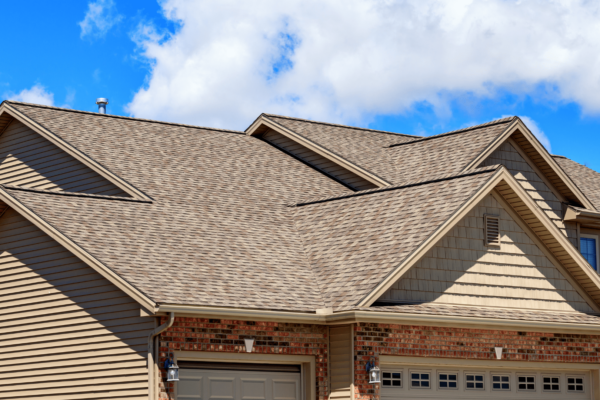The Benefits of Replacing Roof: Is It Worth the Investment?
Is your roof starting to show signs of wear and tear? Are you wondering whether it’s time to replace your roof or if you can hold off for another year or two? Replacing roof is a significant investment, and it’s natural to have some reservations.
However, numerous benefits to replacing your roof can outweigh the initial costs. In this article, we will delve into why you should consider your replacing roof, what to think when doing so, and the key signs that indicate it’s time for a new roof. We’ll also explore the advantages of modern roofing materials, energy efficiency, and the peace of mind that comes with a sturdy roof over your head.
 Benefits of Replacing Roof
Benefits of Replacing Roof
-
High Return on Investment
One of the primary benefits of replacing roof is the high return on investment (ROI) it offers. While a new roof is a substantial upfront expense, you can expect to recoup most, if not all, of the roofing costs when you decide to sell your home. Potential buyers often prefer homes that don’t require immediate structural repairs, and a new roof can significantly boost your property’s resale value.
A study conducted by the National Association of REALTORS® (NAR) and the National Association of the Remodeling Industry (NARI) in 2019 found that 33% of Realtors® believed that a new roof played a crucial role in closing a sale on a home. This statistic highlights how a new roof can make your home more appealing to potential buyers, helping you sell it at a higher price.
-
Improved Curb Appeal
Beyond the financial aspect, a new roofing system can significantly enhance the curb appeal of your home. An aging and deteriorating roof can make your property look rundown and neglected.
However, modern asphalt shingles come in a wide range of colors and styles, some even mimicking the appearance of slate or wood shingles. By choosing the right roofing material and design, you can transform the look of your home for the better.
Not only will you appreciate the visual upgrade, but your neighbors and potential home buyers will also be impressed by the refreshed appearance of your property.
-
Greater Energy Efficiency
Energy efficiency is a vital consideration when it comes to roofing. If your roof is nearing the end of its lifespan, it may need to be more effective in keeping heat away from your home. Older shingles were often not designed to repel heat; instead, they tended to absorb heat and transfer it into the interior of the house.
In contrast, modern shingles are engineered to do more than just keep your home dry. Many of today’s roofing options are designed to reflect heat away from your house, preventing excess heat from entering.
This helps maintain a cooler and more comfortable indoor temperature, reducing the workload on your HVAC (Heating, Ventilation, and Air Conditioning) system. As a result, you can expect lower energy bills and increased savings over time.
Furthermore, the color and design of your new roof can also impact energy costs. Darker-colored shingles tend to absorb more heat than lighter ones. If your existing roof has dark shingles, replacing roof them with a lighter, energy-efficient alternative can contribute to even more significant energy savings.
-
Healthier Home
One of the less obvious but crucial advantages of replacing roof is the improvement in indoor air quality and overall health. Older roofs may not effectively repel water, allowing moisture to seep inside.
Over time, this moisture buildup can lead to the growth of mold and mildew, posing health risks to your family.
Mold exposure can cause various health problems, including issues with the eyes, nose, throat, and lungs. Even individuals who aren’t allergic to mold can experience discomfort and health issues when exposed to it.
By investing in a new roof, you can prevent moisture infiltration and create a healthier living environment for your loved ones.
-
Safety
Your roof serves as a crucial protective barrier for your home, shielding it from debris, falling trees, and strong winds. However, as a roof ages, it becomes more susceptible to structural degradation, compromising its ability to withstand external threats.
Even if the weakening is not visibly apparent from the outside, an aging roof is at risk of failing when subjected to severe weather conditions.
If an older roof is left unattended, it may become unstable and even collapse, potentially causing extensive damage to your property and posing safety hazards. Therefore, taking proactive steps to replace an aging roof is essential, especially if you live in an area prone to storms or high winds.
-
Peace of Mind
Perhaps one of the most valuable benefits of replacing roof is the peace of mind it brings. Instead of constantly worrying about leaks during rainstorms or structural issues during high winds, you can take action to protect your family by installing a sturdy new roof.
Knowing that your home is well-maintained and secure from the top down can significantly reduce your stress and anxiety related to home maintenance.
Additionally, working with a reputable roofing company can provide an extra layer of assurance. A new roof installed by professionals is likely to be covered under a manufacturer’s warranty, which can last anywhere from 25 to 50 years, depending on the terms.
This warranty protects you in case the roofing materials break or become damaged.
However, it’s important to note that a manufacturer’s warranty doesn’t cover damage caused by faulty installation. To ensure the longevity of your roof and enjoy lasting peace of mind, it’s crucial to select a reputable and experienced roofing installation company.
Cutting costs by hiring inexperienced contractors can lead to problems down the road, making it essential to prioritize quality and expertise in your roofing project.
Things to Consider When Replacing Roof
Before proceeding with a roof replacement project, there are several important factors to consider to ensure a successful and cost-effective outcome:
-
Roofing Material Selection
Choosing the right roofing material is a critical decision. The market offers various options, including asphalt shingles, metal roofing, tile roofing, and more. Each material has its unique advantages and drawbacks, so it’s essential to select one that suits your budget, climate, and aesthetic preferences.
-
Roofing Costs
Roofing costs can vary significantly depending on the material chosen, the size and complexity of your roof, and your location. It’s advisable to obtain multiple quotes from reputable roofing contractors to compare prices and determine a realistic budget for your project.
-
Contractor Selection
Selecting the right roofing contractor is crucial to the success of your project. Look for licensed, insured, and experienced professionals who have a track record of quality work. Check references and online reviews to ensure you choose a contractor you can trust.
-
Roofing Permits
Depending on your location and the scope of the project, you may need to obtain permits before replacing roof. It’s essential to check local regulations and obtain the necessary licenses to avoid potential legal issues.
-
Roofing Timeline
Consider the timeline for your roofing project. Weather conditions, contractor availability, and the complexity of the job can all impact the duration of the project. Ensure you have a clear timeline in place to minimize disruptions to your daily life.
-
Roofing Maintenance
Once your new roof is installed, it’s important to establish a regular maintenance schedule to prolong its lifespan. Routine inspections and minor repairs can prevent costly issues in the future.
Signs You Need a New Roof
Now that we’ve discussed the benefits of replacing roof and the factors to consider let’s explore the key signs that indicate it’s time for a new roof. Identifying these signs early can help you avoid more extensive and costly damage to your home:
-
Missing or Damaged Shingles
If you notice missing or damaged shingles on your roof, it’s a clear indication that your roof is deteriorating. Shingles protect your home from the elements, and any compromised shingles can lead to leaks and water damage.
-
Roof Leaks and Water Stains
Interior water leaks and water stains on your ceilings or walls are telltale signs of a roofing problem. These issues should be addressed, as they can lead to mold growth and structural damage if addressed.
-
Sagging Roof
A sagging or drooping roofline is a severe structural issue that requires immediate attention. It indicates significant roof damage and may pose a safety hazard.
-
Excessive Granules in Gutters
Suppose you find an excessive amount of granules from your shingles accumulating in your gutters. In that case, it’s a sign that your shingles are deteriorating. This can affect the integrity and performance of your roof.
-
Roof Age
The age of your roof is a crucial factor to consider. Most asphalt shingle roofs have a lifespan of 20-25 years, while other materials may last longer. If your roof is approaching or exceeding its expected lifespan, it’s wise to start planning for a replacement.
-
Increased Energy Bills
A deteriorating roof can lead to poor insulation and increased energy bills. If you’ve noticed a sudden spike in your heating or cooling costs, your roof’s energy efficiency may be compromised.
-
Mold or Moss Growth
The presence of mold, moss, or algae on your roof is not only unsightly but also a sign of moisture retention. These organisms can further degrade your roofing material and cause damage over time.
-
Roof Rot or Decay
Inspect your roof for signs of rot or decay, especially in wooden components. Soft or spongy areas on the roof’s surface indicate structural problems that require immediate attention.
-
Persistent Ice Dams
If you frequently experience ice dams on your roof during winter, it may indicate poor insulation and ventilation. Addressing this issue may involve both roof repairs and insulation improvements.
Conclusion
In conclusion, the benefits of replacing roof extends beyond mere aesthetics and can significantly impact your home’s value, energy efficiency, and overall well-being. A new roof offers a high return on investment, improves curb appeal, enhances energy efficiency, promotes a healthier living environment, ensures safety, and provides peace of mind. When considering a roof replacement,
it’s crucial to carefully weigh the factors mentioned, select the right roofing material, choose a reputable contractor, obtain necessary permits, plan for maintenance, and be vigilant about identifying signs of roof deterioration.
By taking proactive steps and investing in a new roof when needed, you can safeguard your home, protect your family, and enjoy the numerous advantages that come with a well-maintained and resilient roofing system. Don’t wait until leaks and extensive damage force your hand;
instead, make an informed decision to replace your roof, ultimately benefiting both your immediate comfort and your long-term financial well-being.
If you’re still wondering, “Is it worth getting a new roof?” The answer is a resounding yes, considering all the benefits and advantages it brings. A new roof is not just a home improvement project; it’s an investment in the future of your home and your peace of mind.
Remember, maintaining the integrity of your home starts from the top down, and a solid, reliable roof is the foundation of a safe and comfortable living space. So, if you’re contemplating a roof replacement, take the necessary steps today to enjoy the countless benefits of a brand-new roof.
You can follow us on Social Media
For more information, you can contact us!
